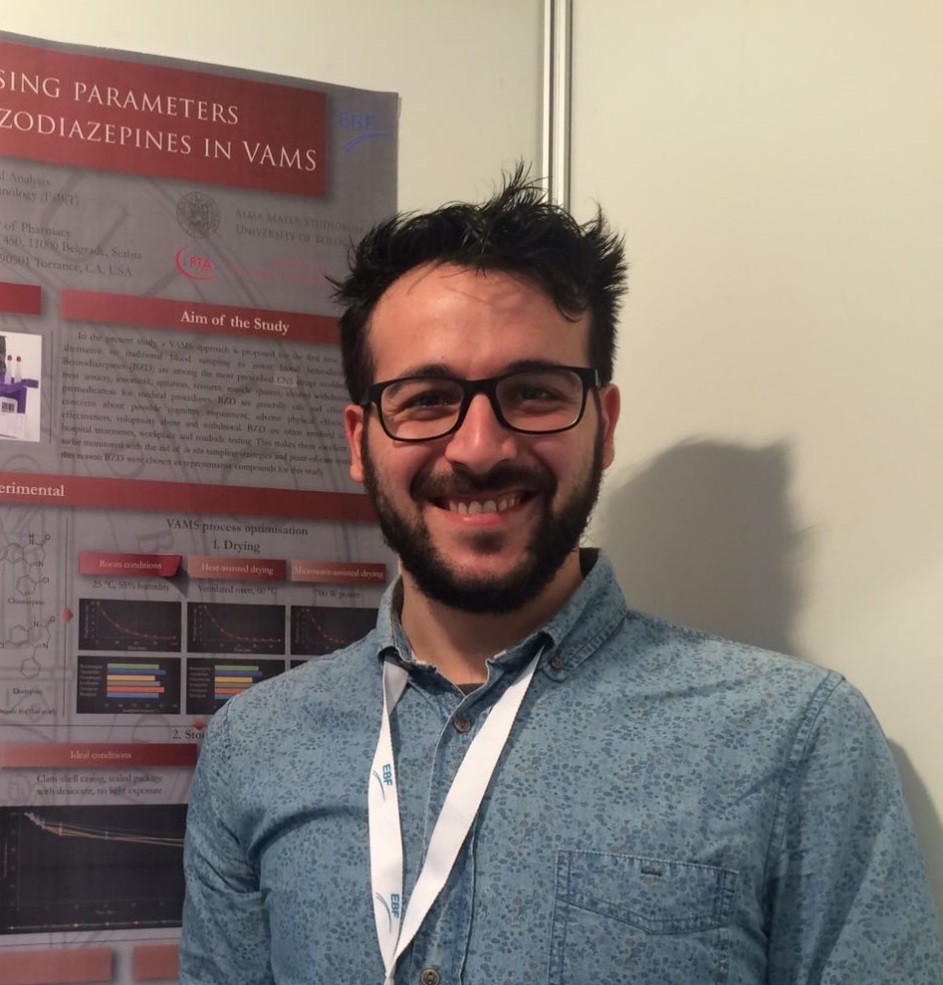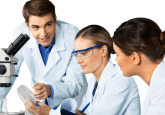2017 New Investigator Award: Michele Protti

 Michele Protti (University of Bologna, Italy)
Michele Protti (University of Bologna, Italy)
What made you chose a career in bioanalysis?
I looked for the first time at the world of bioanalysis in 2011, at the time of my choice for the experimental graduation thesis. I approached this world with curiosity, ambition, but also with the recklessness of a young student who didn’t know exactly what to do with his career.
And then… I was thunderstruck! Since then, bioanalysis is an integral part of my life, every day I see in the real world outside the Lab new potential applications of bioanalysis that can improve people wellbeing. In the end, I think this is the ultimate goal of the whole research.
Describe the main highlights of your bioanalytical work?
Since the beginning, approaching my graduation thesis in Chemistry and Pharmaceutical Technologies at the University of Bologna (Italy), I dealt with the development of novel and advanced analytical strategies for the pretreatment of alternative biological matrices. Under the enterprising and extremely competent leadership of Dr. Laura Mercolini, Head of the Laboratory of Pharmaco-Toxicological Analysis (PTA Lab) I undertook and completed in 2016 my Ph.D. Programme in Chemistry, about hyphenated approaches for the treatment and analysis of complex matrices.
My passion for microsampling and for the development of miniaturised pretreatment procedures, coupled with novel analytical methods for bioactive molecules, has allowed me to be personally involved in several collaborative research projects. These involved and still involves other academic partners, companies, clinics, hospitals, supervisory organisations, law enforcement bodies, and for two years now, anti-doping control agencies, for a research project based on microsampling that I am actually carrying out.
Application field ranges from the therapeutic monitoring of SNC drugs-treated patients (Mercolini et Al., Bioanalysis, 2015) to the investigation on classic drug abuse and novel psychoactive substances (Mercolini and Protti, J Pharm Biomed Anal, 2016), to doping analysis (Mercolini et Al., J Pharm Biomed Anal, 2016), just to name a few.How has your work impacted your laboratory, the bioanalytical field and beyond?
The innovative microsampling strategies and miniaturised sample pretreatment procedures developed, optimised and validated at the PTA Lab are being exploited for therapeutic drug monitoring of patients under antipsychotics treatment, in collaboration with psychiatric clinics. Indeed such feasible and minimally invasive sampling through dried matrix spot (DMS) and volumetric absorptive microsampling (VAMS™) techniques may bring great advantages in terms of patient benefits and compliance, especially for vulnerable subjects as psychiatric patients, infants and the elderly.
In addition, the use of dried microsamples have been proposed and applied by law enforcement bodies and control authorities for the assessment of intoxication states and drug abuse; by drug addiction services in order to monitor cassation therapies; by occupational medicine for workplace testing.
In the last two years, these strategies have also been proposed for the rapid, on-field sampling of athletes for high-throughput screening and confirmation analysis in the framework of sport drug testing activities.
Describe the most difficult challenge you have encountered in your scientific career and how you overcame it?
When dealing with the development of new sampling and pretreatment strategies to be proposed as alternatives to traditional routine methods, the challenges are diverse.
Techniques designed and developed to be highly applicative on a large scale need to be feasible, cost-effective and easily affordable even by less-advanced laboratories; at the same time, they must keep all the reliability and robustness features, in terms of quali-quantitative results, held by the so-called gold standard methods. To do so, in addition to intuitions and out-of-the-box thinking, it is essential to keep a methodical approach to validation and to bridging studies.
Those are fundamental, in order to overlay the results obtained by classical methods to those obtained through the newly developed ones, in order to demonstrate the actual reliability when put into practice in the real world out of the laboratory.
Also, I feel it is essential and equally difficult to “convince” people who will have to implement such techniques, that microsampling is the ultimate way ahead to break free from obsolete and troublesome practices such as phlebotomy. I understand it can be a tough paradigm shift but in this case, communication skills capable to bring research and results outside of Academia are fundamental.Describe your role in bioanalytical communities/groups?
I am currently member of the American Chemical Society (ACS), American Society for Mass Spectrometry (ASMS) and of the European Federation for Medicinal Chemistry (EFMC). I am also an active member of the Italian Chemical Society (SCI), and of the Italian Society of Toxicology (SITox). In addition, the PTA Lab where I am currently Post-Doc Research Fellow is among the collaborative centers of the Italian Commission for the Supervision and Control on Doping, member of the National Early Warning System (NEWS) and of the European Research Area Network on Illicit Drugs (ERANID).
I strongly believe that the creation of research networks and interdisciplinary collaboration strategies among academic, industrial and governmental actors is the key to the expansion and boost of the research, oriented to people wellbeing, enhancement of life quality and of society as a whole.
I also believe that communication, and in particular communicating research is essential today. This is why, in addition to 15 publications on peer-reviewed scientific journals, I am also author of 67 communications (including oral communications, flash communications and poster presentations) within national and international scientific conferences and workshops.
Results, especially if significant, should never stay confined within the four walls of the laboratory.
List up to five of your publications in the field of bioanalysis:
1. 1 Michele Protti, James Rudge, Angelo E. Sberna, Gilberto Gerra, Laura Mercolini. Dried haematic microsamples and LC-MS/MS for the analysis of natural and synthetic cannabinoids. Journal of Chromatography B 1044-1045, 77-86, 2017.
2. 2 Laura Mercolini, Michele Protti, Maria C. Catapano, James Rudge, Angelo E. Sberna. LC-MS/MS and volumetric absorptive microsampling for quantitative bioanalysis of cathinone analogues in dried urine, plasma and oral fluid samples. Journal of Pharmaceutical and Biomedical Analysis 123, 186-194, 2016.
3. 3 Laura Mercolini, Michele Protti. Biosampling strategies for emerging drugs of abuse: towards the future of toxicological and forensic analysis. Journal of Pharmaceutical and Biomedical Analysis 130, 202-2019, 2016.
4. 4 Laura Mercolini, Maria A. Saracino, Michele Protti Current advances in biosampling for therapeutic drug monitoring of psychiatric CNS drugs. Bioanalysis 7, 1925-1942, 2015.
5. 5 Laura Mercolini, Roberto Mandrioli, Michele Protti, Andreas Conca, Lawrence J. Albers, Maria A. Raggi Dried blood spot testing: a novel approach for the therapeutic drug monitoring of ziprasidone-treated patients. Bioanalysis 6, 1487-1495, 2014.
Find out more about this year’s New Investigator Award, the judging panel and the rest of our nominees.




